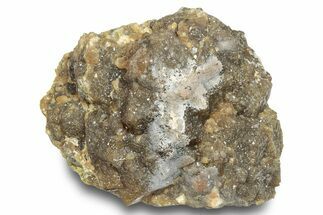This Specimen has been sold.
2.9" Garnet, Diopside & Epidote Association - Afghanistan
This is a gorgeous, 2.9" wide association of yellow-green diopside crystals, translucent green epidote crystals and andradite garnets. This mineral association was collected from Khogyani, Afghanistan and is in great condition.
Diopside is a pyroxene mineral with the chemical formula MgCaSi₂O₆. It is often found as small green crystals within metamorphic and igneous rocks, though it can vary in color including yellow, brown, and black. It is an important indicator rock when searching for deep-source volcanic pipes that may or may not contain diamonds. Geologists searching for these pipes often look for diopside crystal fragments, since they form in nearly the same atmospheric conditions and locations as diamonds. Diopside with deep green coloration is known as chrome diopside.
Andradite is a species of the garnet group, and although not as well-known as some other types of garnets, such as Almandine or pyrope, it is the most lustrous. It tends to be opaque, so most andradite is not gemstone-quality. It occurs in skarns developed in contact-metamorphosed impure limestones or calcic igneous rocks; in chlorite schists and serpentinites; and in alkalic igneous rocks, often titaniferous.
Andradite comes in three varieties: melanite, colored by titanium substitutions for iron in its formula; topazolite, a rare and yellow-green variety; and demantoid, a striking green variety that is one of the world's rarest and most valuable gemstones.
Garnets are nesosilicates with the general formula X3Y2(SiO4)3. There are many species of garnet, including pyrope, almandine, spessartine, uvarovite, andradite, and grossular (varieties of which are hessonite, cinnamon-stone and tsavorite). Garnets are found in a wide variety of colors including red, orange, yellow, green, purple, brown, blue, black, pink, and colorless, though reddish shades are the most common.
Andradite comes in three varieties: melanite, colored by titanium substitutions for iron in its formula; topazolite, a rare and yellow-green variety; and demantoid, a striking green variety that is one of the world's rarest and most valuable gemstones.
Garnets are nesosilicates with the general formula X3Y2(SiO4)3. There are many species of garnet, including pyrope, almandine, spessartine, uvarovite, andradite, and grossular (varieties of which are hessonite, cinnamon-stone and tsavorite). Garnets are found in a wide variety of colors including red, orange, yellow, green, purple, brown, blue, black, pink, and colorless, though reddish shades are the most common.
About Epidote
Epidote is a striking and often green mineral known for its complex crystal structure and vitreous luster. It is a calcium aluminum iron silicate that commonly forms in metamorphic rocks, particularly in regions that have undergone low to medium-grade metamorphism. The color of epidote typically ranges from pistachio green to dark green, although it can occasionally appear yellowish-green or even brown due to varying iron content.
Epidote crystals can appear in prismatic, slender forms or as aggregates, and they often exhibit striations along their length. The mineral’s translucent to transparent appearance and high refractive index give it an attractive, glassy shine.
It is commonly associated with minerals such as quartz, feldspar, and garnet, often forming in metamorphic rocks like schist and gneiss. It can also be found in skarn deposits alongside minerals like calcite, diopside, and amphiboles. These associations can provide insights into the geologic history and metamorphic conditions of the region. Epidote is found in locations worldwide, with notable sources including Austria, Norway, Pakistan, and parts of the United States. Collectors prize epidote for its unique green hues and well-formed crystal clusters.
Epidote is a striking and often green mineral known for its complex crystal structure and vitreous luster. It is a calcium aluminum iron silicate that commonly forms in metamorphic rocks, particularly in regions that have undergone low to medium-grade metamorphism. The color of epidote typically ranges from pistachio green to dark green, although it can occasionally appear yellowish-green or even brown due to varying iron content.
Epidote crystals can appear in prismatic, slender forms or as aggregates, and they often exhibit striations along their length. The mineral’s translucent to transparent appearance and high refractive index give it an attractive, glassy shine.
It is commonly associated with minerals such as quartz, feldspar, and garnet, often forming in metamorphic rocks like schist and gneiss. It can also be found in skarn deposits alongside minerals like calcite, diopside, and amphiboles. These associations can provide insights into the geologic history and metamorphic conditions of the region. Epidote is found in locations worldwide, with notable sources including Austria, Norway, Pakistan, and parts of the United States. Collectors prize epidote for its unique green hues and well-formed crystal clusters.
SPECIES
Garnet var. Andradite, Diopside & Epidote
LOCATION
Khogyani, Afghanistan
SIZE
2.9 x 2.5"
CATEGORY
SUB CATEGORY
ITEM
#122665
 Reviews
Reviews












